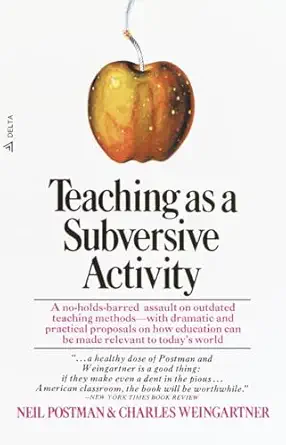Teaching as a Subversive Activity (1969 / 1970)

Co-authored by Neil Postman and Charles Weingartner, Teaching as a Subversive Activity challenges the traditional education system by urging teachers to abandon rigid curricula and instead foster environments where questioning, exploration, and critical thinking are at the core of learning.
Written during the cultural upheaval of the late 1960s, the book argues that schools should not be factories of conformity but laboratories for curiosity. The authors suggest that the goal of education should not be to teach facts, but to teach students how to ask meaningful questions — a radical stance that positioned the teacher as a facilitator rather than an authority.
“The end of education is not thinking; it is acting. It is not knowing what to do, but doing it.”
Core Principles from the Book
- Inquiry Over Answers: Students learn best by asking questions and engaging with uncertainty, not by memorizing information.
- The Teacher as a Learner: Educators should model curiosity and self-reflection rather than authority and control.
- Communication as Learning: True education occurs through dialogue — not monologue — fostering collaboration and meaning-making.
- Deconstruction of “Truth”: Facts are contextual; understanding comes from exploring perspectives, not accepting dogma.
- Relevance to Life: The most effective classrooms connect learning to real-world problems, ethics, and social responsibility.
Why It Still Matters
Decades later, Teaching as a Subversive Activity remains a cornerstone text in progressive education and media literacy. Its critique of passive learning resonates strongly in today’s digital era, where students are overwhelmed with information but often lack the tools to question and interpret it critically.
The book continues to inspire educators, reformers, and lifelong learners to reimagine the classroom — not as a place to store knowledge, but as a community that cultivates freedom of thought and the courage to challenge assumptions.